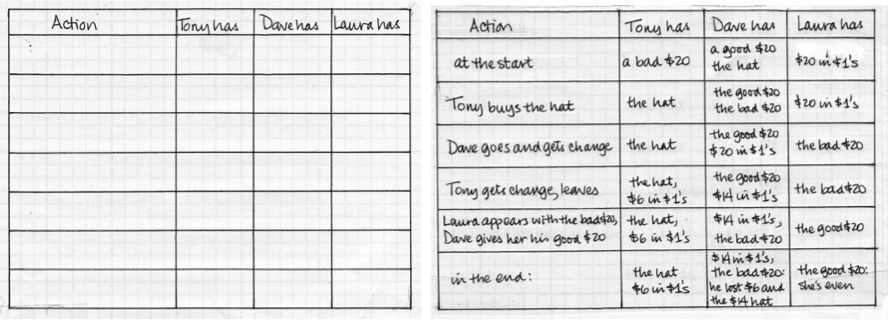Tony goes into Dave's Army-Navy store and buys a hat for $14. He gives Dave a $20 bill. Dave doesn't have any change, so he takes the $20 bill across the street to Laura, the clerk in Watson's hardware store. Laura trades Dave's $20 for twenty $1 bills. Dave comes back and gives Tony $6 in change. Tony takes the hat and the $6 and leaves town forever. Half an hour later Laura comes over, furious. She has discovered that the $20 bill is counterfeit. Dave, of course, makes it good: he gives Laura twenty good dollars (a $20 bill that he has in the till from earlier sales). Question: now that it is all over, who lost money and how much?
Solution
Problems like this one, which have a complicated story line, are used as ice-breakers at conferences. The leader will state the problem and give the crowd a few minutes individually to come up with an answer. Then he divides the crowd into groups: "Everybody who thinks Dave lost $14 come over here. Everybody who thinks Dave lost $6 come over here." Then each sub-group is given the task of figuring out how to convince the other sub-groups that they are correct. Hah! (I've never tried this with a class; it might be fun.)
Solving the Problem: This is a matter of working along carefully, step by step, and keeping track of each character's financial status at each point. Making a table can help. You find out at the end that Dave has lost the $14 hat and also the $6 he gave Tony, so he's out $20. Tony is ahead $20, and Laura stays even.
Heuristics: The heuristics involved are #4, make charts and, as you see below, #8, act the problem out.
Using the Problem with Students: Make this a class activity. A problem like this, which has an ongoing story line, is a lot of fun to act out. Acting it out is a great way to liven up a first-period class on a grey, dreary, rainy morning (or, for that matter, any period, particularly last period, particularly last period on Friday).
You need props: a hat, a counterfeit $20 bill (Monopoly money is fine, or make one), twenty $1 bills (again, don't use real money), and a "good" $20 bill, (which Dave will need later).
And you need the cast of characters: Tony (the bad one), Dave (the sad one, ultimately), and Laura (the mad one).
You need the set: where's Dave's? Where's Watson's?
And you need the director of the show--probably you.
So the action begins: Tony has the $20, Dave has the hat and a $20 in the till, and Laura has the twenty $1's. Let the drama unfold at a slow enough pace for everybody to be keeping track of everything.
At the end, we see that Dave has lost both his hat and the $6 in change he gave Tony (he still has the fourteen $1's from Laura but paid her that $20 from the till). So he's out hat plus $6, or $20. Tony has the hat and the $6 in change. Laura has what she started with.
The solution page has a blank chart, and one that's filled in. You might ask the students to write up the solution using that blank chart, or to make up a chart in their own format.
The heuristics involved are #8: act the problem out, and #4: make charts.
Similar Problems: Another couple of problems like this one are 1180.21, missing dollar, and 1180.22, horse trading.
